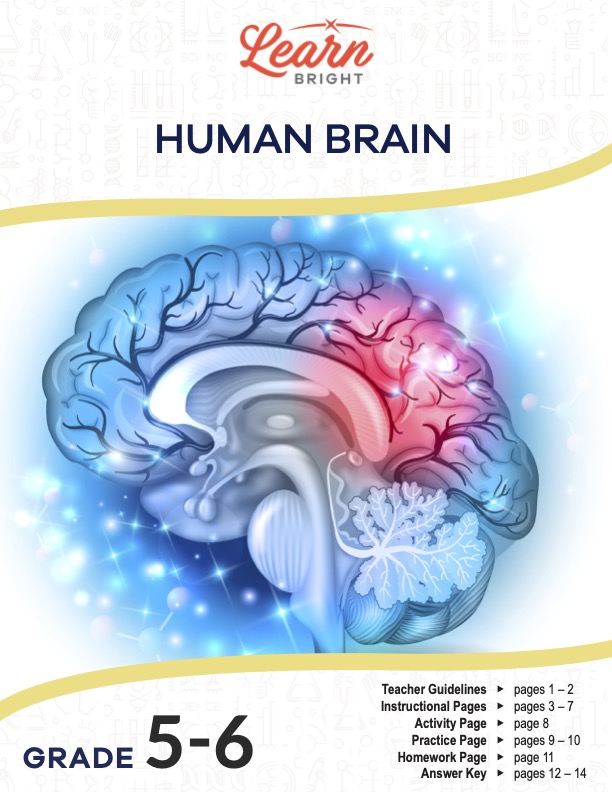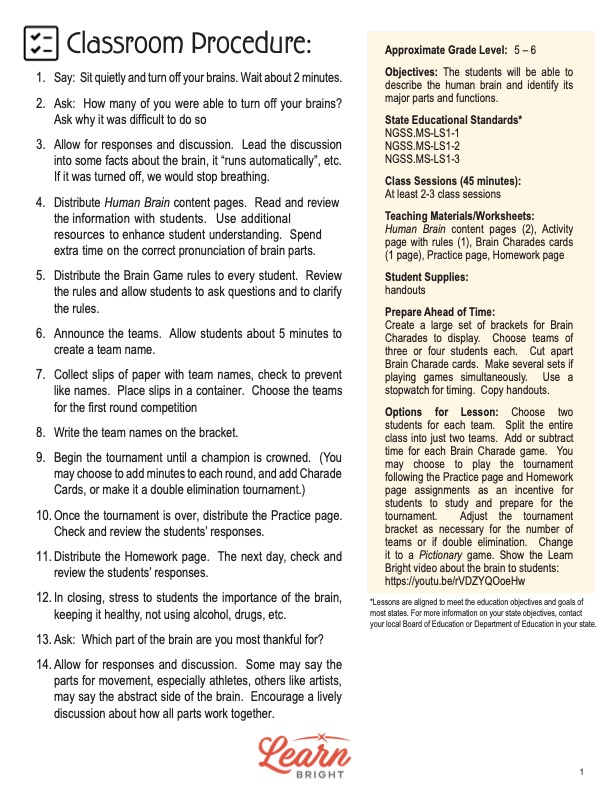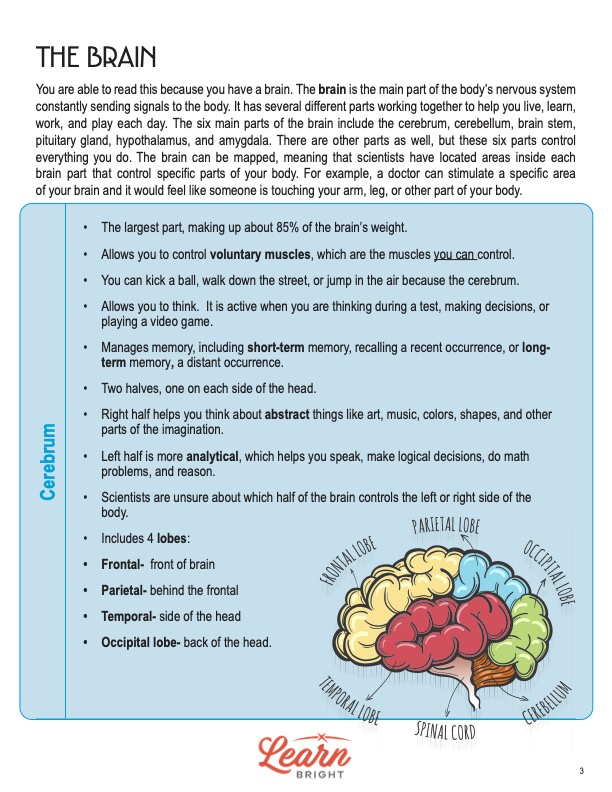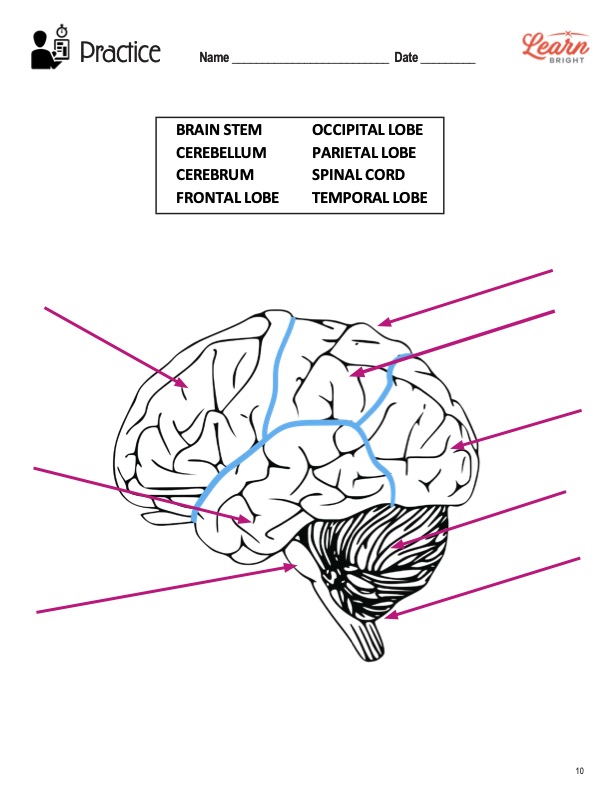Description
What our Human Brain lesson plan includes
Lesson Objectives and Overview: Human Brain teaches students about the major components of the brain and their functions. Students will be able to identify and describe these major parts and functions and learn how they all work together. This lesson is for students in 5th grade and 6th grade.
Classroom Procedure
Every lesson plan provides you with a classroom procedure page that outlines a step-by-step guide to follow. You do not have to follow the guide exactly. The guide helps you organize the lesson and details when to hand out worksheets. It also lists information in the yellow box that you might find useful. You will find the lesson objectives, state standards, and number of class sessions the lesson should take to complete in this area. In addition, it describes the supplies you will need as well as what and how you need to prepare beforehand. You won’t need any extra supplies for this lesson, but you will need to prepare a few things ahead of time. Create a large set of tournament brackets for the Brain Charades activity to display. Divide your students into teams of three or four each. Cut apart the charade cards, and make several sets if you plan to play several games at the same time.
Options for Lesson
The “Options for Lesson” section lists several suggestions for additional activities and tasks or alternate ways to go about certain parts of the lesson. For this lesson, all of the suggestions are related to the brain charades activity worksheet. You could choose two students for each team to increase the number of teams playing in the tournament, or you could split the class into just two teams rather than making it tournament. (In this case, you wouldn’t need make the brackets.) You may even want to adjust the rules a little bit so that you either add or subtract the amount of time students have for each game. Another idea suggests saving the game for after the practice and homework assignments as an incentive for students to study and prepare for the tournament. Another option is to adjust the bracket as necessary for the number of teams or if you want to use double elimination rules. The last idea is to change the game into a drawing game such as Pictionary instead.
Teacher Notes
The paragraph on the teacher notes page provides a little extra information or guidance for the lesson overall. It reminds you to focus your efforts on helping students become familiar with the parts of the brain and how different areas control different parts of the body. It suggests that you use additional resources, like videos, to further journey into the workings of the human brain. You may find and want to use additional content that discusses parts of the brain that this lesson doesn’t cover. You can use the blank lines to write any other thoughts or ideas you have as you prepare.
HUMAN BRAIN LESSON PLAN CONTENT PAGES
The Basics of the Brain
The Human Brain lesson plan contains three pages of content. The first page explains what the brain is and what it does for the body. The brain is the main part of the body’s nervous system and constantly sends signals throughout the body. It has several different parts that work together to ensure we can live, learn, work, and play. The six main parts are the cerebrum, cerebellum, brain stem, pituitary gland, hypothalamus, and amygdala.
There are other parts as well, but these six major parts are the ones that control everything that we do. Scientists are able to create maps of the brain. They have been able to locate areas within this organ that control specific parts or functions of the body. For instance, a doctor can stimulate a certain area of the human brain, and it will feel like someone is touching your arm or leg.
The lesson outlines and explains the functions of each of the six major brain components. It provides a few diagrams that label the different parts. You may want to review these with the class a few times since they will need to memorize where each part is located for one of the worksheets. The instructions dictate that they use their memory and not refer to the content pages for help.
Cerebrum
The biggest part of the brain is the cerebrum. It makes up roughly 85% of the brain’s weight. The cerebrum allows people to control voluntary muscles, which are the muscles that they can control. In other words, the cerebrum is what allows people to kick a ball, walk down the street, or jump in the air. It also allows us to think. Taking a test, making decisions, or playing video games are all things that activate the cerebrum.
In addition, we depend on this important component when it comes to short-term (recalling recent events) and long-term (recalling much older memories) memory. The cerebellum has two halves, one on each side of the head. The right half helps us with abstract things like art, music, and other parts of the imagination. The left half is more analytical and helps us speak, make decisions, and reason things out. Scientists remain unsure about which half of the brain controls each half of the body.
There are four lobes that make up the cerebrum. The frontal lobe is at the front of the brain (hence its name). Behind the frontal lobe is the parietal lobe. The temporal lobe is on the side of the head. Finally, the occipital lobe is at the back of the head. Both halves of the cerebrum have these four lobes.
Brain Stem and Cerebellum
Students will then learn about the brain stem and cerebellum parts of the human brain. The brain stem is responsible for all the functions of the body that are vital to survival. These functions include breathing, digesting food, and circulating blood throughout the body. It is below the cerebrum and in front of the cerebellum. It connects the rest of the brain to the spinal cord.
The brain stem also controls involuntary muscles, which are those that work on their own without our having to think about it. It tells the heart to pump blood to the body and the stomach muscles to break food down. In addition, it sends and receives millions of messages back and forth between the brain and body.
Located in the back of the brain, under the cerebrum, the cerebellum controls balance, movement, and coordination. To put it simply, this part helps us stand, move, and balance. It is only about one-eighth the size of the cerebrum, but it is still a vital part of the brain. Without it, a person would have great difficulty moving around.
The Other Three Parts of the Human Brain
The lesson next describes the pituitary gland. The pituitary gland controls the growth of the body by producing and releasing hormones. Even though it is only about the size of a pea, our bodies would never change as we aged if it didn’t function properly. It also controls sugars and water in the body and keeps our metabolism going. Metabolism relates to how the body uses energy.
Students will then learn about the hypothalamus, which controls the body’s temperature. Because humans are warm-blooded animals, we can control our body temperature. The hypothalamus is the part of the brain that actually makes this happen. When it’s too hot, this part of the brain tells the body to sweat. When it’s too cold, it tells the body to shiver.
Finally, students will learn about the control center for feelings—the amygdala. The amygdala is a group of cells that is responsible for emotions. There are actually two amygdala in the human brain. One is on the left side of the brain, and the other is on the right, but they work together to function correctly.
These six parts connect with the body’s nervous system, which is comprised of thousands of nerves that communicate information to and from the brain. Memories and thoughts move through cells as tiny electrical charges. They connect to one another via synapses, the junctions between two cells. This is how habits develop and how we learn new skills. The more we practice, the stronger those connections become.
HUMAN BRAIN LESSON PLAN WORKSHEETS
The Human Brain lesson plan includes three worksheets: an activity worksheet, a practice worksheet, and a homework assignment. Each one will help students solidify their comprehension of the material in different ways. The guidelines on the classroom procedure page outline when to hand out each worksheet to the class.
BRAIN CHARADES ACTIVITY WORKSHEET
This activity requires some preparation on your part (see the classroom procedure section). Each team of students will first pick a creative name for their team that relates to the brain in some way. Teams will compete against each other in a single-elimination tournament. To play, one player from each team will randomly choose charade cards and act out what it says to do. The remaining members will guess the action and which part of the brain controls that action. All other students must remain silent. If the actor speaks, the team loses a point. Any time the team guesses both the action and the correct brain part, you will give them a point. The game continues for up to five minutes (or more if you choose). Once they time runs out, they will reshuffle the cards for the opposing team.
LABEL THE DIAGRAMS PRACTICE WORKSHEET
The practice worksheet has two diagrams of a human brain. Students must label each diagram using the terms in the word bank. The word bank is different for each diagram.
HUMAN BRAIN HOMEWORK ASSIGNMENT
For the homework assignment, students must circle the correct answer for 18 questions. Several of these questions provide short scenarios that demonstrate how certain parts of the brain can work well or work improperly. You may or may not allow them to use the content pages for reference.
Worksheet Answer Keys
The last few pages of the document are answer keys for the worksheets. The activity answer key lists which charade cards correspond to the various parts of the brain to make it easy for you to ensure students are correct when they guess. For the practice worksheet answer key, the correct answers are in red for both diagrams. Similarly, the answer key for the homework assignment shows red circles around the correct responses.










